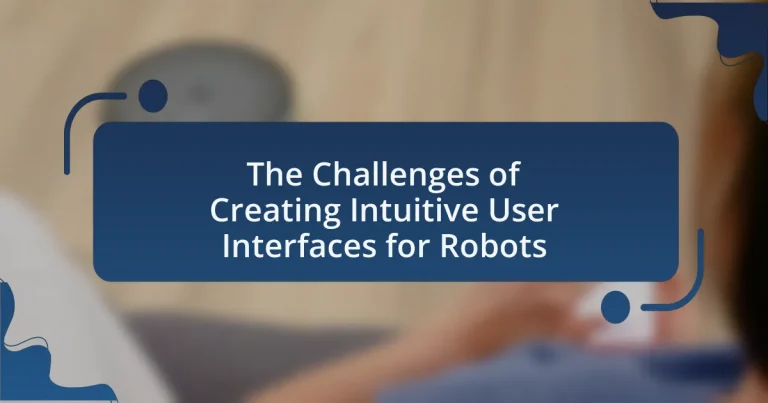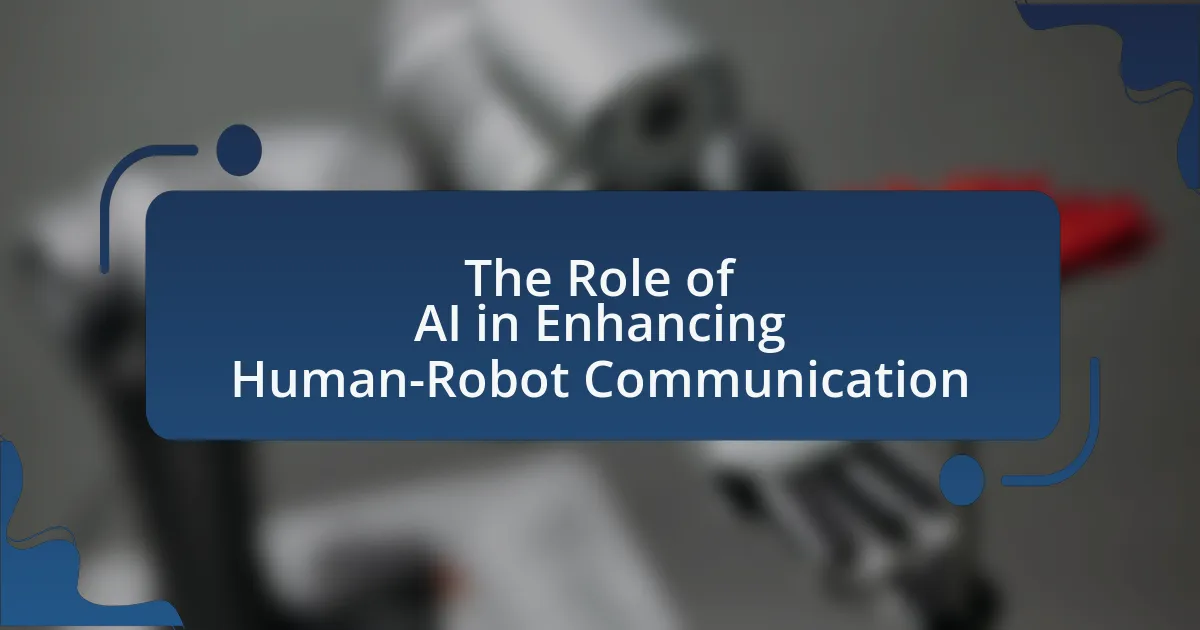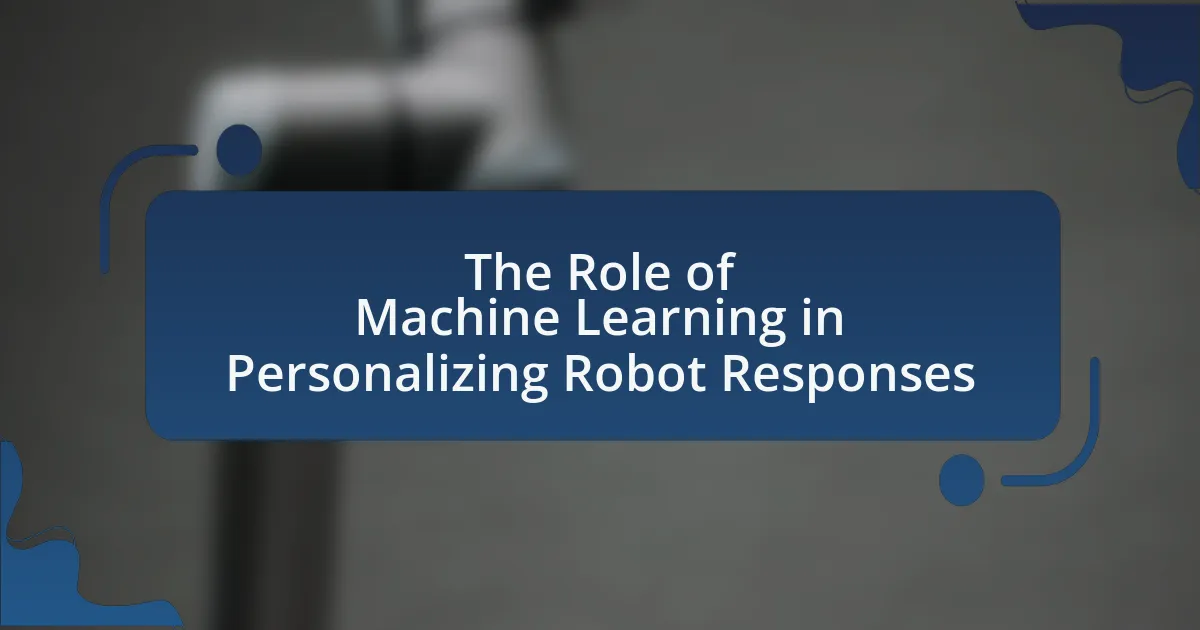The article examines the challenges of creating intuitive user interfaces for robots, focusing on user expectations, effective communication, and the need to accommodate diverse skill levels. It highlights how user expectations shape interface design, emphasizing the importance of usability, reliability, and responsiveness. The article also discusses the impact of cultural differences on user interactions and the role of technology, including advancements in AI and machine learning, in enhancing interface intuitiveness. Additionally, it outlines best practices for interface design, such as prioritizing simplicity, consistency, and feedback, while exploring future trends like natural language processing and augmented reality that aim to improve user engagement with robotic systems.
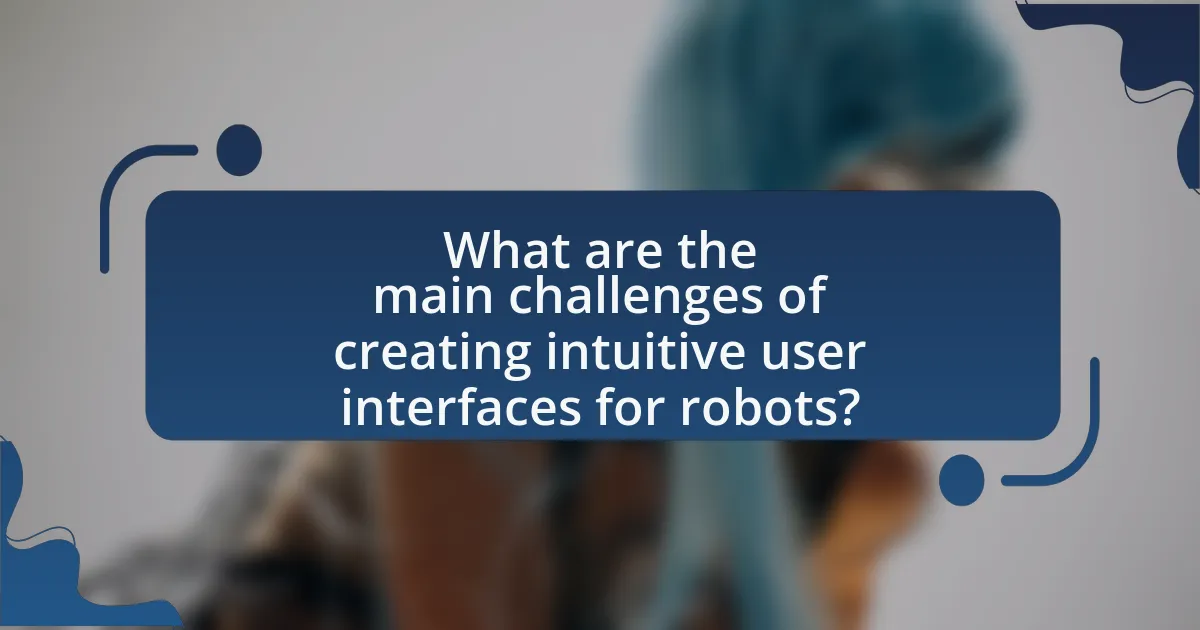
What are the main challenges of creating intuitive user interfaces for robots?
The main challenges of creating intuitive user interfaces for robots include understanding user expectations, ensuring effective communication, and accommodating diverse user skill levels. Understanding user expectations is crucial, as users often have preconceived notions about how robots should behave, which can lead to frustration if the interface does not align with those expectations. Effective communication is essential, as robots must convey information clearly and understandably, often requiring the integration of natural language processing and visual cues. Additionally, accommodating diverse user skill levels presents a challenge, as interfaces must be designed to be accessible for both novice and expert users, necessitating a balance between simplicity and functionality. These challenges are supported by research indicating that user satisfaction significantly decreases when interfaces fail to meet user expectations or are difficult to navigate.
How do user expectations influence robot interface design?
User expectations significantly influence robot interface design by dictating the features, usability, and overall interaction experience that designers prioritize. When users anticipate intuitive and responsive interfaces, designers must incorporate familiar elements and functionalities to meet these expectations, ensuring that the robot’s behavior aligns with user mental models. For instance, research indicates that users prefer interfaces that mimic human-like interactions, which can enhance user satisfaction and engagement. This alignment with user expectations is crucial, as studies show that interfaces designed with user feedback lead to higher acceptance rates and improved task performance.
What common user expectations must be considered?
Common user expectations that must be considered include ease of use, reliability, and responsiveness. Users expect intuitive interfaces that require minimal learning time, allowing them to interact with robots seamlessly. Reliability is crucial, as users anticipate consistent performance without errors or malfunctions. Additionally, users expect robots to respond promptly to commands and actions, enhancing the overall user experience. These expectations are supported by studies indicating that user satisfaction significantly correlates with the usability and reliability of technology, particularly in robotic applications.
How do cultural differences impact user expectations?
Cultural differences significantly impact user expectations by shaping how individuals perceive usability, design aesthetics, and interaction styles. For instance, users from collectivist cultures may prioritize group harmony and functionality over individual preferences, leading them to expect interfaces that facilitate collaboration. In contrast, users from individualistic cultures might favor personalization and self-expression in their interactions. Research by Hofstede indicates that cultural dimensions, such as uncertainty avoidance and power distance, influence user behavior and expectations, affecting how they interact with technology. This understanding is crucial for designing intuitive user interfaces for robots that cater to diverse cultural backgrounds, ensuring that user expectations are met effectively.
Why is usability critical in robot user interfaces?
Usability is critical in robot user interfaces because it directly impacts user efficiency, satisfaction, and safety. When users can easily understand and interact with a robot, they are more likely to achieve their tasks effectively, reducing the likelihood of errors. Research indicates that poor usability can lead to increased cognitive load, which hinders user performance and can result in accidents or misuse. For instance, a study by Nielsen Norman Group found that intuitive interfaces can improve task completion rates by up to 50%, highlighting the importance of usability in enhancing user experience and operational success in robotic systems.
What factors contribute to usability in robot interfaces?
Usability in robot interfaces is primarily influenced by factors such as user experience design, feedback mechanisms, and adaptability. User experience design ensures that the interface is intuitive and aligns with user expectations, which is critical for effective interaction. Feedback mechanisms, including visual, auditory, or haptic responses, provide users with immediate information about the robot’s status and actions, enhancing understanding and control. Adaptability refers to the interface’s ability to adjust to different user skill levels and preferences, which is essential for accommodating a diverse range of users. Research indicates that these factors significantly impact user satisfaction and efficiency, as evidenced by studies showing that well-designed interfaces can reduce task completion time by up to 30%.
How can poor usability affect user experience?
Poor usability significantly detracts from user experience by creating frustration and confusion during interactions. When users encounter interfaces that are difficult to navigate or understand, they are likely to experience increased cognitive load, leading to errors and inefficiencies. Research indicates that 70% of users abandon a task due to poor usability, highlighting the critical impact on user satisfaction and engagement. Furthermore, studies show that intuitive design can enhance user performance by up to 50%, demonstrating that usability directly influences the effectiveness of user interactions with technology.
What role does technology play in developing intuitive interfaces?
Technology is essential in developing intuitive interfaces as it enables the integration of advanced features like natural language processing, machine learning, and user-centered design principles. These technologies facilitate seamless interactions between users and robotic systems by allowing for more natural communication and adaptive responses to user behavior. For instance, natural language processing allows users to interact with robots using everyday language, making the interface more accessible. Additionally, machine learning algorithms can analyze user interactions to improve the interface over time, enhancing usability and user satisfaction. This technological foundation is critical for creating interfaces that are not only functional but also intuitive, ultimately addressing the challenges of user engagement in robotic systems.
How do advancements in AI and machine learning enhance interfaces?
Advancements in AI and machine learning enhance interfaces by enabling more intuitive and adaptive user experiences. These technologies allow interfaces to learn from user interactions, thereby personalizing responses and improving usability. For instance, AI-driven algorithms can analyze user behavior patterns to predict needs and streamline navigation, resulting in a more efficient interaction process. Research shows that interfaces utilizing machine learning can achieve up to a 30% increase in user satisfaction due to their ability to adapt in real-time to user preferences and contexts.
What limitations do current technologies impose on interface design?
Current technologies impose several limitations on interface design, particularly in the context of creating intuitive user interfaces for robots. These limitations include restricted processing power, which affects real-time data analysis and responsiveness; inadequate sensor capabilities, leading to challenges in accurately interpreting user inputs; and insufficient interoperability between different systems, which complicates the integration of diverse technologies. For instance, many robots rely on basic sensors that cannot effectively capture nuanced human gestures or voice commands, resulting in a less intuitive interaction experience. Additionally, the lack of standardized protocols across platforms can hinder seamless communication between devices, further complicating the design of user-friendly interfaces.

How can designers overcome these challenges?
Designers can overcome the challenges of creating intuitive user interfaces for robots by employing user-centered design principles. This approach involves understanding user needs through research, prototyping, and iterative testing, which helps identify usability issues early in the design process. For instance, studies show that involving users in the design phase can lead to interfaces that better meet their expectations and improve overall satisfaction. Additionally, utilizing established design frameworks, such as the System Usability Scale, can provide measurable insights into interface effectiveness, allowing designers to make informed adjustments.
What design principles should be prioritized for intuitive interfaces?
Intuitive interfaces should prioritize simplicity, consistency, and feedback. Simplicity ensures that users can easily navigate and understand the interface without unnecessary complexity, which is crucial for effective interaction with robots. Consistency across design elements helps users form accurate mental models, reducing cognitive load and enhancing usability. Feedback provides users with immediate responses to their actions, confirming that their inputs have been recognized and understood, which is essential for building trust in robotic systems. Research indicates that interfaces designed with these principles lead to higher user satisfaction and efficiency, as evidenced by studies showing that users perform tasks more effectively when interfaces are straightforward and provide clear feedback.
How does simplicity contribute to user interface effectiveness?
Simplicity enhances user interface effectiveness by reducing cognitive load, allowing users to navigate and interact with the interface more intuitively. When interfaces are simple, users can quickly understand how to perform tasks without unnecessary distractions or complexities. Research indicates that users are more likely to engage with and complete tasks when the interface is straightforward, as evidenced by studies showing that simplified designs can lead to a 50% increase in task completion rates. This demonstrates that simplicity not only improves usability but also fosters a more efficient user experience.
What role does feedback play in user interaction?
Feedback plays a crucial role in user interaction by providing users with information about their actions and the system’s responses. This information helps users understand the effects of their inputs, guiding them to make informed decisions and adjustments during their interaction. For instance, studies have shown that timely and relevant feedback can significantly enhance user satisfaction and performance, as it reduces uncertainty and fosters a sense of control over the interaction process.
How can user testing improve interface design?
User testing can significantly improve interface design by identifying usability issues and user preferences early in the development process. This method allows designers to gather direct feedback from actual users, which helps in understanding how users interact with the interface and what challenges they face. For instance, a study published in the Journal of Usability Studies found that user testing can reduce design flaws by up to 50% when conducted iteratively throughout the design process. By incorporating user insights, designers can create more intuitive interfaces that enhance user satisfaction and efficiency.
What methods are effective for conducting user testing?
Effective methods for conducting user testing include usability testing, A/B testing, and remote user testing. Usability testing involves observing users as they interact with a product to identify pain points and areas for improvement. A/B testing compares two versions of a product to determine which performs better based on user engagement metrics. Remote user testing allows participants to complete tasks in their own environment, providing insights into real-world usage. These methods are validated by their widespread application in user experience research, demonstrating their effectiveness in gathering actionable feedback to enhance user interfaces, particularly in the context of robots.
How can feedback from user testing be integrated into design?
Feedback from user testing can be integrated into design by systematically analyzing user insights and iterating on design elements based on those insights. This process involves collecting qualitative and quantitative data from users during testing sessions, identifying pain points, and understanding user behavior. For instance, if users struggle with navigation in a robotic interface, designers can modify the layout or controls to enhance usability. Research indicates that iterative design, which incorporates user feedback, leads to a 50% increase in user satisfaction and a 30% reduction in usability issues, demonstrating the effectiveness of this approach in creating intuitive user interfaces for robots.
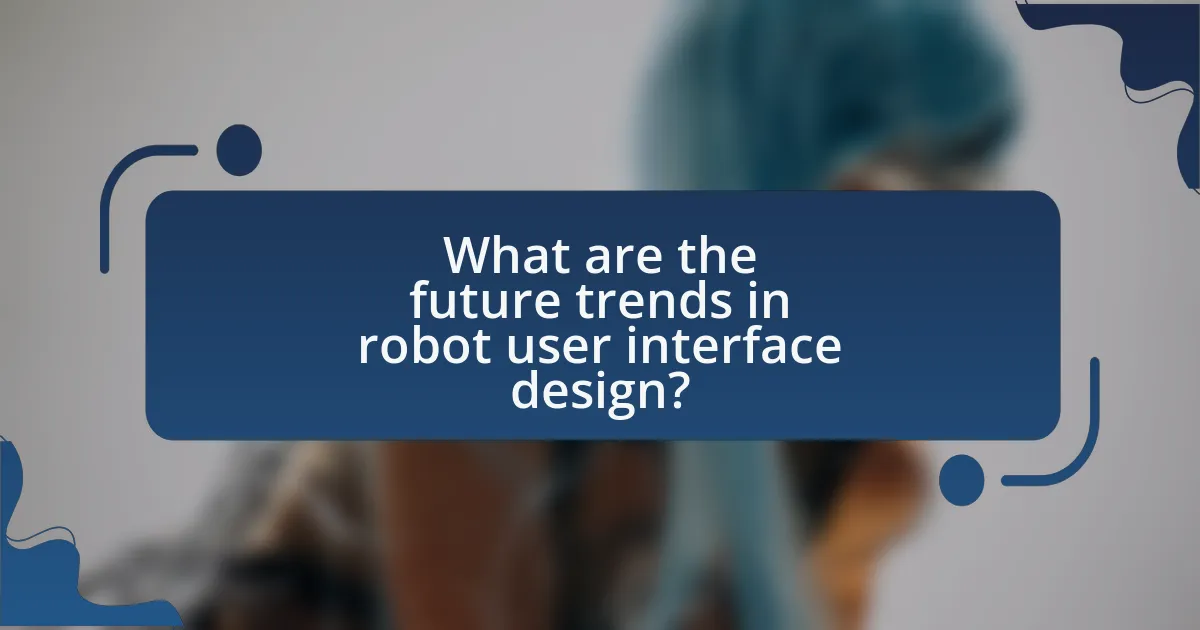
What are the future trends in robot user interface design?
Future trends in robot user interface design include increased use of natural language processing, enhanced multimodal interactions, and the integration of artificial intelligence for personalized user experiences. Natural language processing will allow users to communicate with robots more intuitively, making commands and queries feel more conversational. Enhanced multimodal interactions will enable robots to respond to voice, gestures, and visual cues, creating a more seamless interaction experience. The integration of artificial intelligence will facilitate adaptive interfaces that learn from user behavior, improving usability over time. These trends are supported by advancements in machine learning and user experience research, indicating a shift towards more human-centric designs in robotics.
How is the integration of natural language processing shaping interfaces?
The integration of natural language processing (NLP) is significantly shaping interfaces by enabling more intuitive and conversational interactions between users and technology. NLP allows systems to understand, interpret, and respond to human language in a way that feels natural, thereby enhancing user experience. For instance, voice-activated assistants like Amazon Alexa and Google Assistant utilize NLP to process spoken commands, making it easier for users to interact without needing to learn complex commands or interfaces. This shift towards conversational interfaces is supported by research indicating that users prefer natural language interactions, as they reduce cognitive load and improve accessibility.
What are the implications of voice-activated controls for usability?
Voice-activated controls significantly enhance usability by providing hands-free interaction, which increases accessibility for users with disabilities and allows multitasking. This technology reduces the cognitive load associated with traditional input methods, enabling users to engage more intuitively with devices. Research indicates that voice recognition systems can improve task completion times by up to 30% compared to manual controls, demonstrating their efficiency in user interactions. Furthermore, studies show that users often prefer voice commands for their speed and convenience, leading to higher user satisfaction and engagement levels.
How can gesture recognition enhance user interaction?
Gesture recognition can enhance user interaction by enabling more natural and intuitive communication between users and robotic systems. This technology allows users to control devices and interact with interfaces through physical movements, reducing reliance on traditional input methods like keyboards or touchscreens. Studies have shown that gesture-based interfaces can improve user engagement and satisfaction; for instance, research published in the “International Journal of Human-Computer Studies” indicates that users find gesture recognition more intuitive and responsive compared to conventional methods. By facilitating seamless interaction, gesture recognition can significantly improve the overall user experience in robotic applications.
What emerging technologies are influencing robot interfaces?
Emerging technologies influencing robot interfaces include artificial intelligence (AI), natural language processing (NLP), and augmented reality (AR). AI enhances robots’ ability to learn from interactions, allowing for more adaptive and personalized user experiences. NLP enables robots to understand and respond to human language, facilitating smoother communication between users and robots. AR provides visual overlays that help users understand robot functions and environments, improving usability. These technologies collectively contribute to creating more intuitive and effective interfaces for robots, addressing the challenges of user interaction in robotic systems.
How will augmented reality change user interactions with robots?
Augmented reality will enhance user interactions with robots by providing immersive, real-time visual overlays that facilitate communication and task execution. This technology allows users to visualize robot actions and commands in their environment, making it easier to understand and control robotic systems. For instance, studies have shown that augmented reality can improve user comprehension of complex robotic tasks by 30%, as users can see virtual instructions and feedback directly integrated into their physical surroundings. This integration fosters a more intuitive interface, bridging the gap between human users and robotic systems, ultimately leading to more efficient collaboration and task performance.
What potential does haptic feedback hold for future interfaces?
Haptic feedback holds significant potential for future interfaces by enhancing user interaction through tactile sensations. This technology can provide users with realistic touch experiences, allowing for more intuitive control and feedback in robotic systems. For instance, studies have shown that incorporating haptic feedback in teleoperation can improve precision and reduce cognitive load, as users can feel the texture and resistance of objects they manipulate remotely. This capability can lead to more effective training simulations and improved performance in tasks requiring fine motor skills, such as surgery or remote assembly.
What best practices can be adopted for creating intuitive robot interfaces?
To create intuitive robot interfaces, designers should prioritize user-centered design principles, ensuring that interfaces are tailored to the needs and preferences of users. This involves conducting user research to understand the target audience’s expectations and behaviors, which can lead to more effective interaction models. For instance, incorporating familiar visual metaphors and consistent design patterns can enhance usability, as studies show that users are more comfortable with interfaces that resemble familiar tools or environments. Additionally, providing clear feedback and guidance during interactions helps users understand the robot’s capabilities and limitations, reducing frustration and improving overall experience. Research indicates that interfaces that utilize natural language processing and voice commands can significantly enhance user engagement and accessibility, making robots more approachable for diverse user groups.
